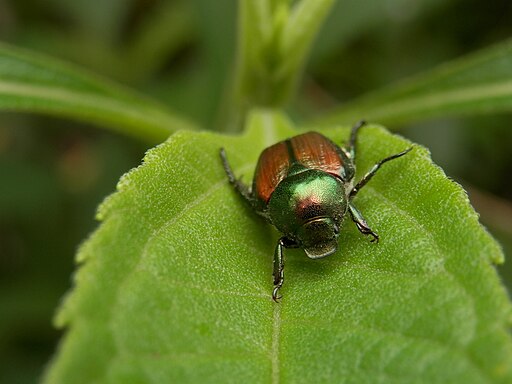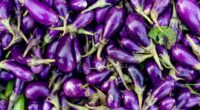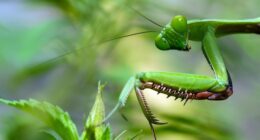June bugs, also known as May beetles or June beetles, are nocturnal insects. Japanese beetles are invasive pests originating from Japan and were accidentally introduced to North America in the early 20th century.
TL;DR June bug Vs. Japanese beetle
June bugs, also known as June beetles or May beetles, are nocturnal insects native to North America. They have a short adult lifespan and feed on leaves but are not major agricultural pests.
Japanese beetles are invasive pests accidentally introduced from Japan, with a metallic green body and coppery-brown wings. They are highly destructive feeders, consuming over 300 plant species, and are active during the day.
What are June Bugs?

June bugs, also known as June beetles or May beetles, are fascinating creatures that belong to the scarab beetle family. These insects are a common sight during late spring and early summer months in many parts of North America. With their distinctive buzzing sound and clumsy flight patterns, they often capture our attention.
These nocturnal insects come in various species, but the most well-known is the Phyllophaga genus. They can range in size from about half an inch to one inch long, with oval-shaped bodies covered in a hard exoskeleton. Their coloration typically ranges from brownish-yellow to reddish-brown.
What are Japanese Beetles?

Japanese beetles (Popillia japonica) are a type of insect that belong to the scarab beetle family. These shiny, metallic green insects have become quite notorious for their destructive feeding habits.
Native to Japan, as their name suggests, they were accidentally introduced to the United States in the early 1900s and have since spread across much of North America.
One characteristic that sets Japanese beetles apart from other insects is their voracious appetite. They will feast on more than 300 different species of plants including roses, grapes, fruit trees, vegetables like corn and beans, as well as ornamental plants found in gardens or landscapes.
June bug Vs. Japanese beetle – Species and Scientific Names
June bug
- Common Name: June bug
- Scientific Name: Phyllophaga spp.
Japanese beetle
- Common Name: Japanese beetle
- Scientific Name: Popillia japonica
Both the June bug and the Japanese beetle are beetles belonging to the same family, Scarabaeidae, but they are different species with distinct characteristics and behaviors.
June bug Vs. Japanese beetle – Origin and Distribution
June bug (Phyllophaga spp.) and Japanese beetle (Popillia japonica) have different origins and distributions.
June bug (Phyllophaga spp.)
- Origin: June bugs are native to North America.
- Distribution: They can be found throughout the United States and parts of Canada. Different species of June bugs may have more localized distributions within this region. They are also found in some parts of Central America.
Japanese beetle (Popillia japonica)
- Origin: The Japanese beetle is native to Japan.
- Distribution: It was accidentally introduced to the United States in the early 20th century, likely through infested soil in shipping crates. Since then, it has become an invasive species in North America.
June bugs are native to North America, while Japanese beetles are originally from Japan but have become invasive in the United States. Both species can be found in the United States, but their origins and specific distribution areas differ.
June bug Vs. Japanese beetle – Life Cycle and Behavior
June Bug (Phyllophaga spp.)
- Life Cycle: June bugs undergo complete metamorphosis, which consists of four stages: egg, larva (grub), pupa, and adult.
- Egg: Female June bugs lay eggs in the soil during late spring to early summer. The eggs hatch in a few weeks.
- Larva (Grub): The grub stage is the most prolonged part of their life cycle, lasting one to three years. Grubs are white, C-shaped larvae that feed on the roots of grass and other plants.
- Pupa: After the larval stage, the grub pupates in a protective cocoon formed in the soil.
- Adult: The adult June bug emerges from the pupa in late spring or early summer. They are typically nocturnal and are attracted to lights.
Behavior
Adult June bugs are often seen flying around at night, attracted to light sources.
They are herbivorous and feed on leaves, flowers, and fruits, but are not considered major agricultural pests.
June bugs are known for their distinctive buzzing sound while in flight, which can be quite loud.
Japanese Beetle (Popillia japonica)
- Life Cycle: Japanese beetles also undergo complete metamorphosis with four life stages: egg, larva (grub), pupa, and adult.
- Egg: The female Japanese beetle lays eggs in the soil during mid-summer. The eggs hatch within a couple of weeks.
- Larva (Grub): The grub stage lasts about 10 months. Grubs feed on the roots of grass and other plants, potentially causing damage to lawns and crops.
- Pupa: After the larval stage, the grub pupates in the soil.
- Adult: Japanese beetles emerge from the pupa in late spring or early summer. They are diurnal (active during the day) and are often seen feeding on various plants.
Behavior
Japanese beetles are voracious feeders and can cause significant damage to a wide range of plants, including ornamental plants, fruits, and vegetables.
They are known for their distinct metallic green color with coppery-brown wing covers.
Japanese beetles are strong fliers and can travel long distances, which contributes to their spread as an invasive species.
June bugs and Japanese beetles undergo complete metamorphosis, but their life cycles differ slightly in terms of timing and behavior. While June bugs are primarily nocturnal and less damaging to crops, Japanese beetles are diurnal, highly destructive to plants, and considered invasive in North America.
June bug Vs. Japanese beetle – Appearance
June Bug (Phyllophaga spp.)
- Size: June bugs are typically larger than Japanese beetles.
- Shape: They have an oval or somewhat rounded body shape.
- Color: June bugs are usually brown or dark brown in color, and some species may have a slightly metallic or iridescent sheen.
- Wings: Their outer wings (elytra) are more leathery and serve as protective covers for the membranous flight wings underneath.
- Antennae: June bugs have short, fan-shaped antennae that are often not as noticeable.
- Legs: They have relatively stout legs.
Japanese Beetle (Popillia japonica)
- Size: Japanese beetles are smaller compared to June bugs.
- Shape: They have a more elongated and narrower body shape.
- Color: Japanese beetles are known for their striking metallic green color on the head and thorax, with coppery-brown wing covers (elytra).
- Wings: Similar to June bugs, they have elytra covering their membranous flight wings.
- Antennae: Japanese beetles have longer, clubbed antennae that are more prominent.
- Legs: Their legs are slender compared to those of June bugs.
The June bug is generally larger, brown or dark brown, and has short fan-shaped antennae. On the other hand, the Japanese beetle is smaller, has a metallic green head and thorax, coppery-brown wing covers, longer clubbed antennae, and slender legs. The distinct appearance of each beetle makes them relatively easy to differentiate from one another.
June bug Vs. Japanese beetle – Feeding Habits
June Bug (Phyllophaga spp.)
- Feeding Habits: Adult June bugs are primarily nocturnal feeders, and they are not considered major agricultural pests. They feed on a variety of plant material, such as leaves, flowers, and fruits. While they may cause minor damage to plants, they are generally not as destructive as Japanese beetles.
Japanese Beetle (Popillia japonica)
- Feeding Habits: Japanese beetles are voracious feeders and are known for their highly destructive feeding habits. They are diurnal (active during the day) and are infamous for causing significant damage to a wide range of plants. They feed on the leaves, flowers, and fruits of over 300 plant species, including ornamental plants, fruits, vegetables, and field crops.
Behavioral Difference
While both the June bug and the Japanese beetle feed on plant material, the major difference lies in their feeding intensity and impact on vegetation. Japanese beetles are considered major agricultural and garden pests due to their extensive feeding damage, which can lead to severe defoliation and reduce crop yields.
The June bug is primarily a nocturnal feeder and may cause minor damage to plants, whereas the Japanese beetle is a diurnal and highly destructive feeder that poses a significant threat to various plants, making it a more serious pest in agricultural and gardening settings.
June bug Vs. Japanese beetle – Seasonal Activity
June Bug (Phyllophaga spp.)
- Adult Activity: Adult June bugs typically emerge from the pupal stage in late spring or early summer, depending on the species and the region. They are active during the warm months, and their peak activity is often in June, which is how they got their common name “June bug.” Adult June bugs are mainly nocturnal, and you might see them flying around lights at night.
- Larval Activity: The larval stage of June bugs, also known as grubs, is more extended and can last from one to three years. During this time, the grubs live in the soil and feed on the roots of grass and other plants. They are most active in the soil during the warmer months.
Japanese Beetle (Popillia japonica)
- Adult Activity: Japanese beetles emerge from the pupal stage in late spring or early summer, typically around June, coinciding with the same time as the June bugs’ peak activity. They are active during the day and are highly visible due to their metallic green and coppery-brown colors. Adult Japanese beetles are most active during the summer months and can be seen feeding on plants.
- Larval Activity: Like June bugs, Japanese beetle larvae (grubs) live in the soil and feed on the roots of plants. Their larval activity also occurs during the warmer months, and they can cause damage to lawns and plants during this time.
Behavioral Difference
Both June bugs and Japanese beetles have active adult stages during the warm months, with June being a significant month for both species. However, the Japanese beetle is more active during the day (diurnal) compared to the June bug, which is primarily nocturnal.
The seasonal activity of both June bugs and Japanese beetles revolves around the warmer months, with adult emergence and activity typically occurring in late spring and summer. While the June bug is mainly nocturnal, the Japanese beetle is active during the day.
Image Credits
Featured Image By – Ryan Hodnett, via Wikimedia Commons
Image 1 By – Beatrice Murch on Flickr
Image 2 By – Ryan Hodnett, via Wikimedia Commons








